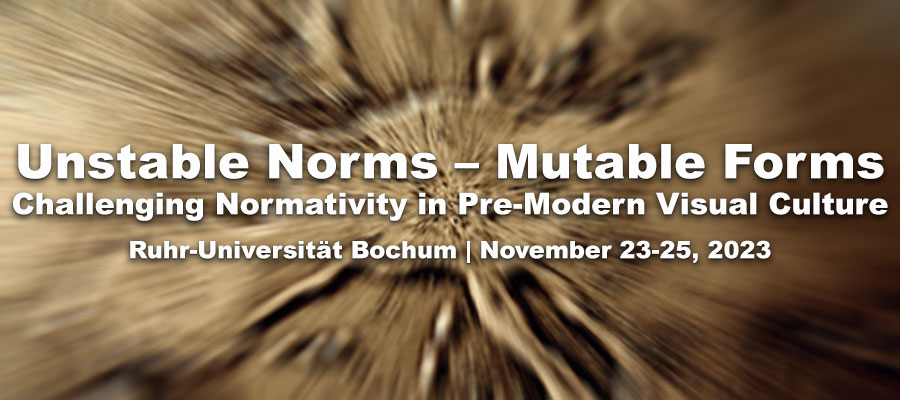Unstable Norms – Mutable Forms. Challenging Normativity in Pre-Modern Visual Culture, Ruhr-Universität Bochum, November 23-25, 2023
Submissions due October 1, 2023
According to common sense knowledge, visuality and pictoriality seem inherently ambiguous. Pictures and artifacts depend on the beholder’s viewpoint and perspective, which are, however, mobile, and modifiable. Contrary to the mutability of forms, norms and normativity represent standards, facts, or a stable basis for evaluative judgements. The relationship between normativity and visuality is rarely questioned as a complex ratio, as visuality does not map onto the constitutive demarcation of the norm and notion of normativity.
Pre-modern studies often tend to foreground established or assumed normative expectations and standards of appropriateness (decorum), as well as forms of authorization (legal, religious, political) and adequacy within classificatory systems (genre theory). According to this approach regulatory structures are emphasized within frameworks of stability and continuity, leaving limited space for transformation, reevaluation, or even contestation of normativities.
Unstable Norms – Mutable Forms challenges this common opposition of norm and form, and proposes to locate normativity, or rather the process of normativization, within the variable realm of visuality and pictoriality.
The research-conference seeks to bring together a plurality of perspectives and approaches and invites proposals both on pre-modern European and/or on non-western subjects that explore the (multi-)normative efficacy of visuality in deep networks of visual ecologies.
We invite papers across all career levels that sketch out different polycentric and multinormative contexts of specific artifacts and visualities and contribute to the broader frame of research about inter- or cross-culturality, trans-migration of forms, but also praxeological approaches to the production of cultural meaning and legally instituted as well as culturally implemented norms and normativities.
Papers may present specific case studies of relevant singular images or objects (artifacts), or focus on visual spaces of normative efficacy, and/or address visuality, perception and normativity conceptually beyond paradigms of language & propositionality.
Areas of interest include, but are not limited to:
- Authority: How do institutions of normative authority (legal, political, religious) instrumentalize/employ visuality/visual imagery to set norms and normative standards?
- Commonality: How does visuality foster a common sense perception shared collectively by political communities (communal state imagined)?
- Experience: What are the implications of sensory experiences and perceptions within mediations of normative efficacy of images/artifacts?
- Mediality: How do images and artifacts/objects relate, (inter)connect and mediate between a phenomenal sphere of the visible world and a normative sphere?
- Praxeology: How do practices of normativization build on practices of visualization and visual perception?
- Spaces: How do visual spaces organize the normative efficacy of multiple, coordinated images within different registers of normative authority?
Contributors are invited to present papers of about 25 min. The format of the research-conference is intended to emphasize a collaborative forum of exchange between colleagues invested in or currently engaging in research on dimensions of normative efficacies of visual culture.
